Pouring in Punta Arenas, Chile
- Samantha Martin
- Mar 4, 2023
- 3 min read
Our ship arrived in Punta Arenas on a very rainy day and we weren't even sure we were going to get off. But being the adventurers we are - we decided lunch was worth getting off for!! If nothing else...

It was a sign that in the pouring rain we had a cab right outside the Port doors and we met John, our cabbie who used to be a jockey in NY! Forced to come back due to family health issues he now drives tourists like us around his city which is one of the largest in Patagonia. Even through the gross weather and rain he took us to the highest point overlooking the city then to see the town of over 120K people populated from immigrants from Spain and Croatia.

With a few highlights, John drove us by the Nao Victoria Museum. This museum exhibits a full-size replica of the first ship ever to circumnavigate the world: Ferdinand Magellan's Nao Victoria. Since October 2011, the museum has added a full-size replica of the James Caird, used by Ernest Shackleton during his Imperial Trans-Antarctic Expedition with the Endurance.
We also stopped at this massive statue honoring Ferdinand Magellan in the city center where it is said if you "kiss or rub" the foot of the Native man - you will return!
We gave him a great foot massage!
John dropped us across from the Port at his favorite restaurant and it was yet another impressive meal - more crab. Dre had a crab salad and their empanadas were out of this world!
It was a short maybe 2-3 hour visit on shore but worth every minute even if we were soaked like drowning rats - we could say we had been, seen and eaten in Punta Arenas and met a pretty cool NY jockey!
PS: It was also in Punta Arenas that I fell in love with the art related to the Hain ceremony of the Selk'nam people.
The Selk'nam, also known as the Onawo or Ona people, are an indigenous people in the Patagonian region of southern Argentina and Chile, including the Tierra del Fuego islands. They were one of the last native groups in South America to be encountered by migrant Europeans in the late 19th century. In the mid-19th century, there were about 4000 Selk'nam; by 1919 there were 297, and by 1930 just over 100.
They are considered extinct as a tribe. The exploration of gold and the introduction of farming in the region of Tierra del Fuego led to genocide of the Selk'nam. Joubert Yantén Gómez, a Chilean mestizo of part Selk'nam ancestry, has taught himself the language and is considered the only speaker; he uses the name Keyuk.
While the Selk'nam are closely associated with living in the northeastern area of Tierra del Fuego, they are believed to have originated as a people on the mainland. Thousands of years ago, they migrated by canoe across the Strait of Magellan.Their territory in the early Holocene probably ranged as far as the Cerro Benítez area of the Cerro Toro mountain range in Chile.
The ceremony where men painted their faces and wore triangular style hats was a ceremony into manhood and it enchanted me. Young males were called to a dark hut. There they would be attacked by "spirits", who were people dressed as supernatural beings. The children were taught to believe in and fear these spirits at childhood and were threatened by them in case they misbehaved. Their task in this rite of passage was to unmask the spirits; when the boys saw that the spirits were human, they were told a story of world creation related to the sun and moon. In a related story, they were told that in the past women used to be disguised as spirits to control men. When the men discovered the masquerade, they, in turn, would threaten women as spirits. According to the men, the women never learned that the masked males were not truly spirits, but the males found out at the initiation rite.
The contemporary ceremonies used this interplay in somewhat of a joking way. After the first day, related ceremonies and rituals took place. Males showed their "strength" in front of women by fighting spirits (who were other males but the women supposedly did not know it) in some theatrical fights. Each spirit was played with traditional actions, words and gestures, so that everyone could identify it. The best spirit actors from previous Hains were called again to impersonate spirits in later Hains.
I bought a piece of small wooden art similar to what would have taken place in a Hain ceremony. Red/white and Black were the colors they used - so to say our "color" palette was similar is an understatement. LOL.


















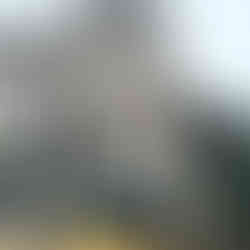








































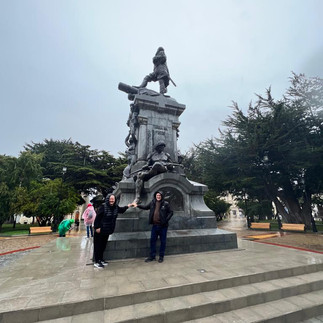





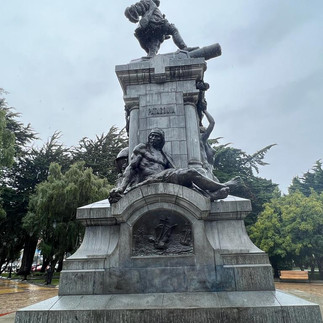



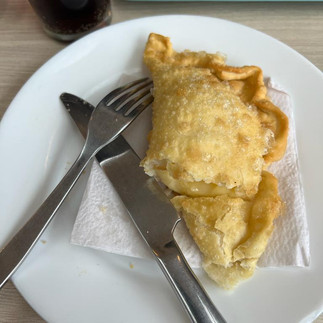





















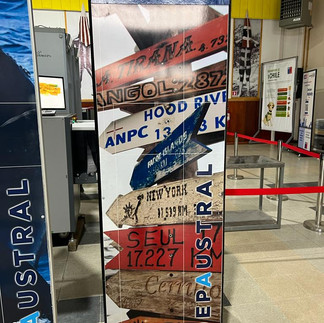



Comments